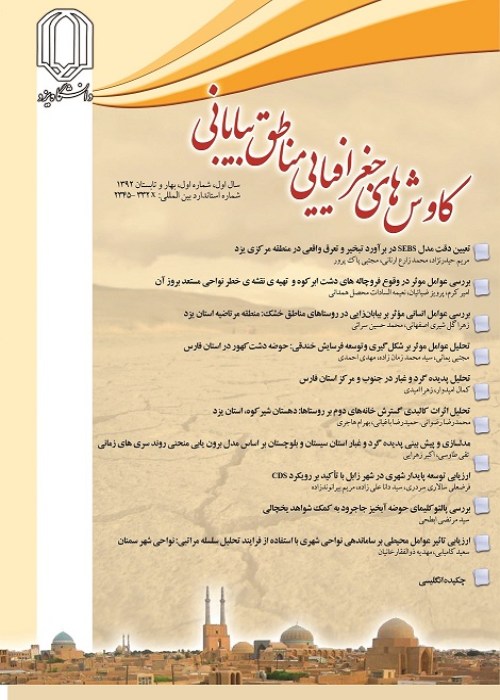The Role of State in empowerment rural communities Case study: Kashan region in central Iran
One of the most important goals of forming states is to provide welfare and development for the society and the development process always involves the action of the state. Therefore, the nature of states, political and ideological philosophy and its structure play a key role in the development process, including rural development. Since the formation of the centralized state in Iran and after 1316, planning has started in its current form, and after 60 years, 12 programs have been prepared in the country, 11 of which have been implemented. During the years before the revolution, 6 programs were prepared and 5 programs were implemented. After the revolution, 6 programs were prepared and 5 programs were implemented, and the sixth program is being completed. In Iran, most of the stages of rural development have been done within the framework of five-year plans, and investment is the most important tool of the state to achieve rural development. Rural management approach until 1970, in most countries of the world, was influenced by the dominance of top-down development management policies and approaches, which followed the emergence of environmental challenges and socio-economic inequalities, the field of attention and change in bottom-up development approach. It has been provided since the 1980s in order to balance rural settlements. Therefore, in recent decades, empowerment has been proposed as a mechanism for rural development in Iran. But were the realities that took place in the country's rurals homogeneous with the demands and goals of the programs? In other words, considering the high volume of credits that are spent every year in rural settlements, the question can be raised that what does investing in rural settlements have to do with empowering the villagers? Has the agent of change been able to bring about the necessary changes and transformations in order to empower the villagers? In this study, by recognizing state investments in rural and its role in empowering villagers, how they affect the rurals of Kashan was analyzed. The method of the present study is descriptive-analytical. The statistical population was 15255 rural households in Kashan district and the sample size was 316 people. In this research, using the classification method and using a three-dimensional matrix, indicators such as state investment (effective index), geographical location of the rural and population were considered as effective indicators for determining the sample rurals and Finally, 12 rurals were selected. In this article, SPSS software was used to assess the validity and reliability of the questionnaire, so that using KMO test, the validity of the rural household head questionnaire to measure the level of rural empowerment is equal to 0.867 and the validity of the rural household head questionnaire to measure investment The state is calculated to be 0.826. Also, based on the results of the structural validity test, Cronbach's alpha coefficient obtained from the rural household heads questionnaire to measure the level of rural empowerment is equal to 0.974 and the rural household heads questionnaire to measure state investment is equal to 0.846. In this way, the validity and reliability of the questionnaire is confirmed. To explain the relationships between independent and dependent variables, TOPSIS technique and regression analysis and coefficient of determination (R2) were used and for other spatial analysis, SPSS and GIS software were used. The results show that according to the ranking of rurals, 75% of the studied rurals had poor and moderate empowerment. Also, 67% of the studied rurals were evaluated with poor and medium investment. Findings from field studies indicate a strong, positive and direct relationship between the two variables of investment and rural empowerment (P = 0.000). In other words, based on the coefficient of determination, 13.5% of the variance of rural empowerment is explained by state investment. As a result, through regression analysis, it can be acknowledged that with increasing state investment in the studied rurals, the rate of rural empowerment also increases. Therefore, rural empowerment is studied as a new approach in the development of rural areas, with a systematic, integrated and combined view, so that self-determination, competence, impact, significance and trust emerge and organize as the driving force of empowerment in rural communities. In this way, the right to development and honorable life in rural areas can be realized objectively. In fact, due to their structural and functional nature, rurals are related to all factors of human life and the challenges ahead cannot be solved with a one-dimensional view. In the combined view, all factors are effective in empowering the villagers and the absence of one of the factors challenges the process of empowering rural communities. According to what has been said, the results of the article provide some strategic points: Lack of careful study and evaluation of developments in rural areas after the arrival of investments and on the other hand different perceptions of the concepts of capacity building and empowerment in practice has caused problems in rural society Stay tuned. Finally, in order to achieve the empowerment of local communities through the role of state in the developmentalist perspective, there are significant proposals that should be pursued through the state, realistic and targeted facilitation models. Thus, in sustainable rural development programs, participatory and facilitator planning, realistic, bottom-up and decentralized, conducting regional and local planning studies, deepening indigenous knowledge-based in rural issues, promoting individual responsibility at the design levels and Program implementation must be considered.
Empowerment , Investment , State , rural , capacity building
- حق عضویت دریافتی صرف حمایت از نشریات عضو و نگهداری، تکمیل و توسعه مگیران میشود.
- پرداخت حق اشتراک و دانلود مقالات اجازه بازنشر آن در سایر رسانههای چاپی و دیجیتال را به کاربر نمیدهد.


